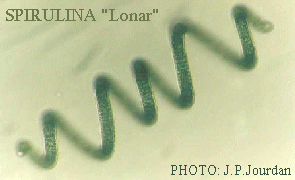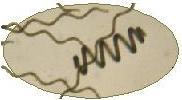|
| INFORMATIONS paper about SPIRULINA and its capacity to reduce MALNUTRITION IN FOOD EMERGENCIES ON THE WEB: http://malnutritionzero.online.fr |
| There are many reasons, but there
is no good reason, why children must suffer from malnutrition. We have seen this kind of picture so often that it hardly attracts our attention. Yet, 33,000 children 0 to 5 years old die each day because of malnutrition. before use of spirulina  Kwashiorkor, in the Ga dialect of Ghana means "the disease the first child gets when the second is on the way" and is largely due to deficiency in proteins, vitamins, and trace elements. All these can be provided in a spoonful of Spirulina each day. Malnutrition usually involves also a lack of calories which are obtained through energy foods such as cereals, fats, and oils. |
 SPIRULINA, or its prototype ancestor, has been around for over 3 billion years . We used to call it "blue-green algae" but more correctly it is a Cyanoprokaryote - a billion years more primitive than algae or green plants. And it is the difference between Spirulina and our ordinary foods that makes it so interesting. |
| SPIRULINA is microscopic in size and grows in highly
alkaline salty waters where our disease-producing
microbes can't grow. | The string of cells in a filament of Spirulina has no cellulose in the cell walls so we can digest it easily |
  |
 More than a thousand years ago the Olmecs, ancestors of the Aztecs of Mexico, were harvesting Spirulina from alkaline lakes,drying it in the sun, and eating it  Today the Kanembous of Chad will tell you that they have eaten it throughout their history. With cereals added, it is a complete food - and that is the way the Aztecs and the Kanembous prepared! |
10 grams of Spirulina satisfies the B12 vitamin needs of children up to 8 years old. Spirulina is also effective against anemia because of its great amount of available iron.  |
2 grams of Spirulina a day provides enough beta-carotene to protect
against xerophthalmia - the cause for blindness in about 250,000 persons yearly-.  |
 Comparison of essential amino acids 
Its amino-acid profile comparing very favorably with the FAO standard protein and with egg protein. | Spirulina can help you make it the best!  How do you grow Spirulina? It grows naturally in many countries, in otherwise unproductive alkaline lakes. These can be exploited as in Chad.  But quality and production can be increased by growing it in special basins near the source of alkaline water. |
|
and sold through health food stores worldwide. |
|
|
The size and complexity of a Spirulina farm depends on the quantity needed, the number of emergency victims to aid , the natural resources available, the climate, the economic infrastructure (transport, power, water),etc..
|






